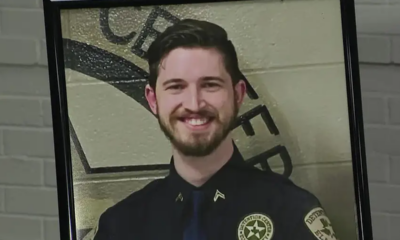Entertainment
For 20 years, he's played 'Saw's' boogeyman. He doesn't see it as a trap

I’m sitting across the table from veteran actor Tobin Bell, whose gaze I try to hold. Between us lies a hefty metal briefcase containing nine composition books. One for each “Saw” film he’s appeared in. Two decades of rigorous preparation to play a horror mastermind.
The first page of handwritten notes for 2004’s “Saw” includes a drawn spiral interrogating the likes, dislikes and motivations of John “Jigsaw” Kramer, the methodical, hyper-intelligent, deadly-contraption designer who some call a righteous vigilante and others a ruthless killer.
“Each film is a different story and John’s in a different place,” Bell tells me, wearing a dark red-carpet-ready suit. “Same guy but different circumstances.” When speaking about his morally questionable character’s philosophy, Bell occasionally quotes Kramer’s phrases verbatim, with the same muted ferocity and growly voice as I’ve heard him do on screen.
“Live or die, make your choice,” he adds, sending chills down my spine on what would otherwise be an unremarkable sunny afternoon at the Lionsgate offices in Santa Monica.
Bell and Shawnee Smith in 2006’s “Saw III.”
(Lionsgate)
As part of this year’s Beyond Fest, Bell will attend a 20th anniversary screening of the first “Saw” in its unrated version on Friday at the Egyptian Theatre. (Later in the month, the chapter that kicked off the gruesome franchise will return to theaters for a limited time.)
Bell, 82, an acting savant who broke into cinema’s foreground in his sixties, explains that the pages are occupied by a series of questions about the character. They start with the most basic details — “Where am I?” for example — and evolve into increasingly specific queries until they form an inverse triangle brimming with insight he’s deciphered on his own.
He learned this method from Oscar-winning actor Ellen Burstyn at the Actors Studio in New York City back in the ’70s and has applied it to every role he’s landed since.
“By the time I get to actually rolling the camera I’m up to 128 answers,” Bell says. “You never know everything, but hopefully I know enough so I don’t go mad trying to play someone I don’t f— know at all.”

“I wanted to just follow my instinct rather than some kind of idea of a career.” Bell says of his early days that led him to acting.
(Jason Armond / Los Angeles Times)
He has always pursued the kind of lived-in performances of actors such as Montgomery Cliff, Gary Cooper or Spencer Tracy, whose movies Bell says he watched in the theater as a child in his hometown of Weymouth, Mass. every Saturday. “They became their characters,” he says of those screen legends. “You didn’t feel like they were indicating.”
Before stepping into the still-expanding “Saw” saga, Bell had been a working actor for almost three decades, amassing a varied collection of screen credits. Among them were memorable supporting parts in the racially charged crime thriller “Mississippi Burning” and Sydney Pollack’s “The Firm” (two of the four times he’s acted opposite Gene Hackman).
He watched Sidney Lumet direct Paul Newman in “The Verdict” while sitting in the courtroom next to Bruce Willis, another unknown at the time. And he’d experienced the heartbreak of being left on the cutting room floor after working with Martin Scorsese for “Goodfellas.”
“I had a scene with [Robert] De Niro that got cut,” he says. “You’ve got to be prepared for that s— too. I’m now in it only for a handshake and I say, ‘Come into my office.’ ”
Although Bell worked in summer-stock theater as a young man, he attended Boston University to study journalism, with specific aims to work in broadcast television. (In an alternate universe, Jigsaw would have become Walter Cronkite.) It was there that the 1963 assassination of John F. Kennedy would reset the course of his future.
Soon after the tragedy, Bell snuck into a drama-department-only session to hear Hume Cronyn and Jessica Tandy speak about acting as an honorable profession. That day, he concluded the world didn’t need one more talking head and decided to become an artist.
“Kennedy says in a speech to the poet Robert Frost that the artist is the last great defense of freedom, and that the artist has a love-hate relationship with society and keeps us on our toes,” Bell recalls. “I felt I no longer had any responsibility to anything. I wanted to just follow my instinct rather than some kind of idea of a career.”

“I always thought I was going to be a romantic leading man,” Bell says. “But an agent also once told me, ‘If you want to work, Tobin, they’ve got to see you as something.’ ”
(Jason Armond / Los Angeles Times)
With a mattress tied to the top of his car, a resolute Bell moved to New York City in 1964 after being accepted at the Neighborhood Playhouse School of the Theatre. Little did he know that in order to chase his acting goals, he would be laying on his back painting the underside of stairwells in a 17-story apartment building to make a living.
“I worked at 53 part-time jobs to keep myself going for more than 20 years in New York,” he says. “I loaded trucks, parked cars at the Hilton garage, bussed tables, waited tables, tended bar. I worked as background and a stand-in in 35 films before I ever spoke.”
His entry into an artistic life was far from linear, however. At one point during his time in New York, Bell married and had a child. In need of steady income, he took a master’s degree in environmental science and for the next six years created educational experiences for school children on the Hudson River, catching, observing and releasing fish.
Throughout it all, Bell held onto a strong conviction. “As much stage work and television as I did in New York, I believed I would become a film actor,” he says. Being part of the Actor Studio, a membership-only organization for professionals, help him keep that dream alive.
“I had a place to belong,” Bell says. “If they took you into the Actors Studio, it made one say to oneself, ‘Maybe I have something. Maybe I’m good enough.’ ”
But the years piled on and one day, a scene moderator at the famed acting workshop suggested that in order to advance his career, Bell should go to Hollywood and play “bad guys.”
“I always thought I was going to be a romantic leading man,” Bell says, remembering the frustration. “But an agent also once told me, ‘If you want to work, Tobin, they’ve got to see you as something.’ ”

Bell in 2023’s “Saw X,” which earned some of the franchise’s best reviews. “It’s all in the writing,” Bell says.
(Lionsgate)
Then came Alan Parker’s 1988 “Mississippi Burning,” in which Bell played an FBI agent. Bell remembers the late British director asking him, “You know why I had you come in, Tobin?” Parker then pointed at the headshot that Bell was using and said, “Because there’s power in that headshot.” A year later, on the recommendation of his “Mississippi Burning” co-star Kevin Dunn, Bell moved to Los Angeles.
He wasn’t here two weeks before he was cast as a criminal in the pilot episode of the 1990 television series “Broken Badges” that would shoot in Vancouver, Canada. From there, one job after another followed and for the first time he was able to make a living solely working as an actor. The quality of the projects ranged from compelling to forgettable. You may have seen him in one episode of “The Sopranos” as the head of a military academy, or on “Seinfeld” as a no-nonsense record store owner.
“I’ve learned more doing crap than I’ve learned doing good stuff,” he says. “Because you have to try to make it better, more interesting.”
“Saw” would eventually come his way in a fortuitous manner, like most breaks. He’d played Patrick Dempsey’s father on the TV show “Once and Again,” and while his character was a shadowy figure, Bell’s potent, piercing voice cut through. That series and “Saw” shared the same casting director, Amy Lippens, so when the debuting Australian director James Wan needed a voice for Jigsaw’s tapes in “Saw,” she suggested Bell.
It wasn’t until the first sequel, “Saw II” that Bell felt more substantial ownership of the character of John Kramer, whom he describes as a “King Lear-size guy,” making suggestions for the screenplay, including dialogue, which he has continued to do for each new film. And though Bell doesn’t condone Kramer’s actions, he understands his disdain for those he traps.
“John feels that the world has been taken over by mediocre people,” Bell says. “He believes we all have to deal with the consequences of what we create. And that these people are not appreciative of what they have.”

“When I was a kid I didn’t like going to horror films,” Bell says. “As soon as the scary part of a film would come up, I’d be down behind the seat.”
(Jason Armond / Los Angeles Times)
Admittedly, Bell has never been a fan of horror (though he was impressed by the Australian slasher “Wolf Creek”). He prefers historical films and period dramas. But through conventions and casual meetings with horror fans, he’s gained an appreciation for their devotion to the genre and the thoughtfulness of their questions about Kramer’s worldview. He also has his own theory about why people like being scared.
“It’s a visceral experience that you can’t control,” Bell says. “You’re not just sitting, passively watching. All of a sudden you [jumps up from his chair, startled]. Some people like that. Not my cup of tea, necessarily. When I was a kid I didn’t like going to horror films. As soon as the scary part of a film would come up, I’d be down behind the seat.”
When I ask if he’s ever felt pigeonholed in the billion-dollar-grossing phenomenon of “Saw,” Bell suggests that every actor gets pigeonholed, whether as “an ingenue, the girl next door,” or in his case, a “bad guy.”
“If within being pigeonholed I can create a rich acting experience — which is why I became an actor — pigeonhole me, go ahead,” Bell says. “It’s every artist’s responsibility to create within whatever is given to him and it’s my job to change your perception of me. If you want to perceive me in a certain way, maybe you’ll see me differently when you see the next film.”
About the upcoming “Saw XI” slated for release during the fall of 2025, Bell confirmed he’s a main part of it. The hope, he says, after the reinvigorated critical and audience reception to last year’s Mexico-set “Saw X,” is to continue elevating the quality of the series.
“It’s all in the writing,” he adds. Bell believes horror films can be as layered as those of any other genre. “It’s not all one guy outside the screen door with sidelight on him.” And the fans, he says, always want to talk to him about the big moral questions of “Saw,” not the gory particulars.
“I’m really excited about continuing to develop him,” he says. “John Kramer is not done. There’s more to learn.”
Even after 50 years devoted to acting, there’s just as much left to be seen from Bell, who is also writing a memoir and his own screenplays — he’s putting on one of the pieces he’s penned at the Actors Studio soon. As he starts a new composition book for another Jigsaw tale, his own storied life keeps adding pages.

Movie Reviews
‘Homestead’ Review: It’s the End of the World as We Know It (and You Might Feel Scammed)

Ben Smallbone’s “Homestead” takes place in a world where foreigners detonate a nuclear bomb off the coast of Los Angeles, the protagonists are saved because they own a Tesla, Bitcoin is the only valuable currency, and the truth can only be told on Right Wing radio. For some people that’s a selling point. For many others, it’s a list of red flags.
It’s easy to think of films like “Homestead” as if they live on the fringe of mainstream media, but though this particular film isn’t a major studio release, they’re hardly uncommon. Hit movies like “Black Hawk Down” and “300” have shamelessly vilified non-white antagonists, portraying them as fodder for heroic, mostly white hunks to mow down with impunity, sometimes in dramatic slow-motion. “Forrest Gump” is the story of a man who does everything he’s told to do, like joining the Army and embracing capitalism and participating in anti-communist propaganda, and he becomes a great American success story. Meanwhile, the love of his life suffers decades of indignity by throwing in with anti-war protesters and Black Panthers, and for all her trouble she dies of AIDS.
The point is, this is not an unusual starting point for a film. “Homestead” is up front about it. It’s clear from the start who this movie is for and what this movie respects. What is surprising is that this production, based on the first of a series of novels by Jeff Kirkham and Jason Ross, also has real conversations about moral conflicts and ethical crossroads. By the end, it even declares that Christian charity is more important — and also more productive — than selfish nationalism. For a minute, right before the credits roll, even people who aren’t in the film’s target demographic might be forced to admit that “Homestead” is, for what it is, one of the better films of its ilk.
And then the movie whizzes all that good will down its leg at the last possible second, contradicting its own morals in a shameless attempt to bilk the audience.
We’ll get back to that. “Homestead” stars Neal McDonough (“Tulsa King”) and Dawn Olivieri (“Lioness”) as Ian and Jenna Ross, a fabulously wealthy couple whose gigantic estate, vast hoard of doomsday supplies and seemingly unlimited arsenal make them uniquely prepared to survive the country’s collapse. At least one major city has been nuked, the power has gone out across the nation and everyone who didn’t prepare for doomsday scenarios is looking pretty silly right now. They’re also looking directly at the Ross estate, Homestead, as their possible salvation.
As such, Ian enlists a team of ex-Navy SEALs to guard Homestead. They’re led by Jeff Eriksson (Bailey Chase, “Longmire”), who uses the opportunity to keep his own family safe. His teenage son, Abe (Tyler Lofton), is the same age as Ian’s daughter Claire (Olivia Sanabia), and nobody else is a teenager, so that romantic subplot is a foregone conclusion. Jeff also has a daughter named Georgie (Georgiana White) who has psychic visions of the future. You might think that would be important later, but leave the fortune-telling to Georgie because she knows (as far as this movie is concerned) that it won’t.
Tensions flare between Ian, who only wants to hold the fort until the American government gets its act together, and Jeff, who assumes civilization will quickly collapse like soufflé at a Gwar concert. Meanwhile, the hungry refugees, some of whom are Ian’s friends and associates, camp outside their gates, desperate to get to safety. Jenna wants to give them food and shelter, but Ian is doing the math and says their supplies won’t last: “What you give to them, you’re taking from us. It’s that simple.”
Gloom and doom fantasies like “Homestead” take place in the very contrived situations where everything you’ve always feared, and for which everyone mocked you for believing in, finally come to pass. ‘Oh no, the government is here to help,’ in the form of a sniveling bureaucrat who wants to inventory Homestead’s supplies and redistribute them to people in need — that monster. Thank God we bought the Tesla with the “Bioweapon Defense Mode,” that wasn’t paranoid at all.

Then again, in the midst of all this anti-refugee rhetoric and pro-billionaire propaganda, cracks in “Homestead’s” façade start to form. Ian’s pragmatism isn’t preventing Homestead from running out of supplies. Jeff’s paranoia seems to be costing more lives than it saves. There’s even a scene where the same woman whose life was saved by a Tesla bemoans how dangerous the vehicle was when her family got attacked by looters, and screams, “Why?! Why did we buy a Tesla?!”
By the end, “Homestead” has explored at least some nuanced perspectives on the real moral issues it raises. With a mostly game cast and efficient, professional direction by Smallbone (“Stoned Cold Country”), it’s not a badly made movie from a technical perspective. And the film’s final message, espousing the positive Christian value of charity, and both the importance and practicality of being generous to the needy, is hard to dispute.
Until, again, the movie’s actual ending. This part won’t require a “spoiler warning” because, A.) It doesn’t spoil the plot; and B.) It’s more like a warning label. This part of the film should have been clearly labeled on the package — like “Smoking causes cancer” or “This paint contains lead.”
It’s a bit of an annoyance to discover that “Homestead” is actually the pilot episode of an ongoing series, which you are expected to commit to now that you’ve bought into it with cold, hard cash. Not that there’s anything horribly wrong with that storytelling approach, but you probably went into this theater expecting a standalone movie and it’s hard not to feel a bit scammed, like you just bought a brand-new AAA game and found out most of its content is still locked behind an additional paywall. The TV series version of “Homestead” isn’t even mentioned on the film’s Wikipedia page, at least not by the time this review was written.
But more than that, “Homestead” ends with a cast member breaking character, speaking directly to the audience, and saying that with Christmas right around the corner, you should be thinking about charity. But they don’t suggest donating to the needy, like the actual film preaches. Instead, they tell you to give more money to the filmmakers. You are encouraged, with the help of an on-screen QR code that stays on-camera throughout the whole credits, to buy a stranger a ticket to “Homestead,” which they may or may not even use, thus artificially inflating the film’s box office numbers and the industry’s perception of its success. It would be one thing if they were straightforward about this: “Please give us money to make more stuff like this.” That’s not the worst thing in the world. But to couch this in terms of charity? It’s very difficult not to take issue with that.
Is this a bad business model? That depends on your values. If you value business, sure, that’s a way to make money. You show people a film designed to convince them that they should be charitable and then tell them to be charitable by giving you more money. Is it ethical? Is it a little hypocritical? Is it not just a little hypocritical, but in outright defiance of everything you just said you believed in?
I suppose your mileage may vary. I couldn’t help but feel like I was being scammed. Just when I was finally enjoying the film, I was given every reason not to. Any movie that espouses the Christian value of generosity and then tells its audience the best way to be charitable is to make the filmmakers richer is hard to recommend in good conscience, even if it is otherwise pretty well made.
“Homestead” is now playing in theaters.

Entertainment
Review: Vengeance is sumptuously served in an epic French take on 'The Count of Monte Cristo'

The brawny, bloodlust howl of “Gladiator II” isn’t your only opportunity for sweeping period spectacle this season, thanks to the renewed allure that OG adventure author Alexandre Dumas has exerted over the French film industry of late.
Last year’s hearty two-part “The Three Musketeers” (“D’Artagnan” and “Milady”) has now been followed up by an even grander and no less enjoyable import: a new adaptation of “The Count of Monte Cristo,” directed by “Musketeers” screenwriters and official Dumas-philes Matthieu Delaporte and Alexandre de La Patellière. Moviegoers will want to augment their starchy, sinewy Roman vengeance diet with the herby Gallic mother sauce battering this “Monte Cristo” — after all, “Gladiator” tips its helmet to “Ben-Hur,” which was directly inspired by Dumas’ payback classic.
And like any multicourse French feast worth its indulgence, this one clocks in at three hours. But that time flies by, akin to a cozy night in with an episode binge. This zesty condensation of an 18-volume, 1300-page epic is a model of streamlining, even if the narrative’s many tantalizing threads, emotions and complications could stand to be fleshed out even more. That’s the irony, though, of rapt investment in a tale conveying the weight of decades: The nuance is earned, and whether it’s well-applied becomes the difference between a merely ripping yarn and a satisfyingly complete one.
But this absence of subtlety is barely a criticism, because what is on display here, whether on land or at sea, marked by bloom or doom, is a gorgeous, gripping pleasure. For starters, there’s the superb casting of brooding, almond-eyed Pierre Niney (“Frantz”), his man-of-few-words intensity suggesting the offspring of a swashbuckler and a troubled art-house romantic. That alchemy becomes a potent asset as his Edmond, a young ship’s captain framed for treason by his jealous friend Fernand (Bastien Bouillon) and resentful crewmate Danglars (Patrick Mille) and sent up for life by corrupt prosecutor Villefort (Laurent Lafitte), goes from whirlwind victim to masked-and-mysterious long-game plotter.
Help comes first with a wise, mentoring Italian cellmate (Pierfrancesco Favino) and a thrillingly depicted escape after 14 years (a mere blip to us) on an island prison. Appearing again in disguise as a wealthy, worldly, black-clad count (but harboring an elaborate plan of retribution), Edmond glides back into the prosperous lives of the men who betrayed him. He also discovers a son (Vassili Schneider) that Fernand, now a war hero, fathered after scooping up Edmond’s bereft fiancée Mercédès (Anaïs Demoustier) for himself. At the Count’s side are an embittered, orphaned young man (Julien de Saint Jean) and woman (Anamaria Vartolomei) with reasons of their own for becoming adoptees to their benefactor’s scheme.
Delaporte and De La Patellière understand that Dumas’ type of novelistic revenge, whether froid or chaud, is best served onscreen in the most picturesque European locations, with cinematographer Nicolas Bolduc’s cameras ready to swoop and soar as needed, and paced to gallop, never dawdle. Again, it might have been nice if the film had lingered more in certain intimate moments, especially when Niney gets his big declaration-of-intent scene, alone in a church, railing at God, ready to settle scores. That moment almost demands a fiery extended soliloquy, not the rushed version on offer.
But the filmmakers know when to elongate tension elsewhere, as in a deliciously mean-spirited dinner scene in which the Count, armed with his unwitting targets’ secret sins, toys with them, a performance that also betrays an inkling of his cruelty’s perilousness. Of course, as “Monte Cristo” plays out, we’re meant to question all that is wrought by a cold-justice mindset, and yes, those lessons become a bit of a moral buzzkill. But that’s only after so much to relish from the exploits of one of literature’s archetypal punishers, who welcomes nightmares, he explains, because “They keep my wounds fresh.” Joyeux noël, mes amis!
‘The Count of Monte Cristo’
In French, with English subtitles
Rated: PG-13, for adventure violence/swordplay and some sensuality
Running time: 2 hours, 58 minutes
Playing: Opens Friday, Dec. 20 at Laemmle Royal and AMC The Americana at Brand 18
Movie Reviews
‘Carry-On’ Movie Review: A ‘Die Hard’ Style Christmas Thriller You Definitely Need To Watch

Carry-On
One of the great debates around Christmas time is whether the classic Bruce Willis action-movie Die Hard should be considered a Christmas movie or not. Sure, it takes place at Christmastime, but is it really a Christmas movie the same way Home Alone or Miracle On 34th Street are Christmas movies?
The obvious answer is “Yes” though a more nuanced one would be “It’s up to you.” If you consider it a Christmas movie, it’s a Christmas movie. If you don’t, that’s cool by me. “To each their own” is an old saying that more people should study and practice.
Whether you consider Die Hard a Christmas movie or not will determine whether you consider Netflix’s new thriller, Carry-On a Christmas movie. Like Die Hard, it takes place near Christmas and like Die Hard 2 it takes place in an airport. Unlike Die Hard, it does not have the star power of Bruce Willis to elevate it into the halls of classic action movies. On the other hand, it’s much better than the later, lousier Die Hard films that released after Die Hard With A Vengeance, perhaps the greatest in the entire franchise.
Carry-On will never be considered a Christmas classic or an all-time great action-thriller, but it’s still a lot of fun and I’m happy we have another holiday action flick that doesn’t suck, because a lot of Christmas movies across genres are pretty terrible.
The movie stars Taron Egerton as Ethan Kopek, a TSA agent stuck in a job he hates with a remarkably patient and attractive girlfriend, Nora, played by Sofia Carson. They learn they’re having a baby, because having a pregnant girlfriend makes the stakes that much higher when things go bad. Nora also works at the airport, but not as a TSA agent. She tells Ethan that all she wants for Christmas is for him to follow his dreams of becoming a police officer.
Things take a turn for the worse when a mysterious criminal, only known as Traveler, shows up. Jason Bateman is terrific in the role. He’s casually, almost nonchalantly, villainous. Using Nora’s life as collateral, he forces Ethan to allow a suitcase through the baggage check. The contents of the luggage turn out to be worse than Ethan could ever imagine. What follows is a tense series of events as Ethan tries (and often fails) to outsmart the Traveler and prevent a terrible tragedy, all without getting his girlfriend and unborn baby killed.
Danielle Deadwyler plays Detective Elena Cole, a police officer investigating a murder which leads her down a trail of breadcrumbs right to the airport where she dives headfirst into the conflict playing out there. The Rossi plays the Traveler’s sniper and tech genius, Watcher. And Breaking Bad’s Dean Norris plays Ethan’s boss, Phil Sarkowski. It’s a good cast overall, though mostly the film focuses on Ethan and Traveler and their interactions.
The movie works because it does a great job at keeping the tension high and the pacing tight. It never outwears its welcome, moving along at a nice clip, with most of its best moments just a conversation between Ethan and Traveler. There’s action, but not Die Hard levels of action.
I did feel like the ending was a bit dangly, with some big plot points unresolved. I won’t spoil any of that because, well, you should watch for yourself. And while the writing is just fine throughout, it’s nothing special either. There are no classic yippee-ki-yay lines here. I doubt I’ll rewatch this over the years, not because there’s anything particularly wrong with the movie, but because there’s nothing particularly stellar about it, either. Carry-On is a fun, tense, popcorn movie with some holiday tinsel on top. Give it a watch.
-

 Politics1 week ago
Politics1 week agoCanadian premier threatens to cut off energy imports to US if Trump imposes tariff on country
-
/cdn.vox-cdn.com/uploads/chorus_asset/file/25782636/247422_ChatGPT_anniversary_CVirginia.jpg)
/cdn.vox-cdn.com/uploads/chorus_asset/file/25782636/247422_ChatGPT_anniversary_CVirginia.jpg) Technology1 week ago
Technology1 week agoInside the launch — and future — of ChatGPT
-
/cdn.vox-cdn.com/uploads/chorus_asset/file/25789444/1258459915.jpg)
/cdn.vox-cdn.com/uploads/chorus_asset/file/25789444/1258459915.jpg) Technology1 week ago
Technology1 week agoOpenAI cofounder Ilya Sutskever says the way AI is built is about to change
-

 Politics1 week ago
Politics1 week agoU.S. Supreme Court will decide if oil industry may sue to block California's zero-emissions goal
-
/cdn.vox-cdn.com/uploads/chorus_asset/file/25546252/STK169_Mark_Zuckerburg_CVIRGINIA_D.jpg)
/cdn.vox-cdn.com/uploads/chorus_asset/file/25546252/STK169_Mark_Zuckerburg_CVIRGINIA_D.jpg) Technology1 week ago
Technology1 week agoMeta asks the US government to block OpenAI’s switch to a for-profit
-

 Politics1 week ago
Politics1 week agoConservative group debuts major ad buy in key senators' states as 'soft appeal' for Hegseth, Gabbard, Patel
-

 Business5 days ago
Business5 days agoFreddie Freeman's World Series walk-off grand slam baseball sells at auction for $1.56 million
-
/cdn.vox-cdn.com/uploads/chorus_asset/file/23951353/STK043_VRG_Illo_N_Barclay_3_Meta.jpg)
/cdn.vox-cdn.com/uploads/chorus_asset/file/23951353/STK043_VRG_Illo_N_Barclay_3_Meta.jpg) Technology5 days ago
Technology5 days agoMeta’s Instagram boss: who posted something matters more in the AI age


















